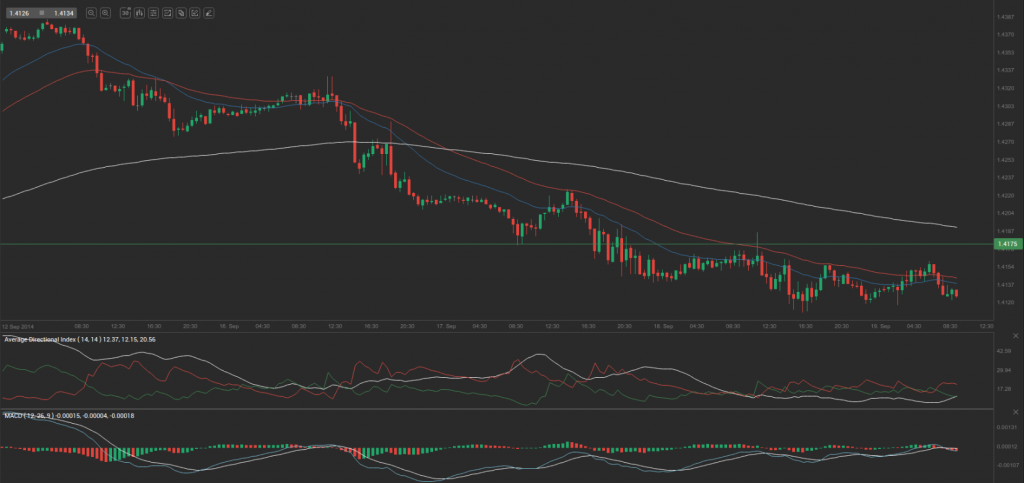Yesterday’s trade saw EUR/CAD within the range of 1.4106-1.4184. The pair closed at 1.4131, losing 0.13% on a daily basis.
At 6:54 GMT today EUR/CAD was down 0.03% for the day to trade at 1.4130. The pair broke the first key weekly support and touched a daily low at 1.4123 during early Asian trade.
Fundamental view
Euro zone
Current Account
The surplus on Euro zones seasonally adjusted current account probably expanded to 14.3 billion EUR in July from 13.1 billion EUR in June.
Euro areas current account (without a seasonal adjustment) produced a surplus at the amount of 20.78 billion EUR in June, or the largest figure since March.
The current account reflects the difference between savings and investments in the Euro area. It is the sum of the balance of trade, net current transfers (cash transfers) and net income from abroad (earnings from investments made abroad plus money sent by individuals working abroad to their families back home, minus payments made to foreign investors).
A current account surplus indicates that the net foreign assets of the region have increased by the respective amount, while a deficit suggests the opposite. A nation with a surplus on its current account is considered as a net lender to the rest of the world, while a current account deficit puts it in the position of a net borrower. A net lender is consuming less than it is producing, which means it is saving and those savings are being invested abroad, or foreign assets are created. A net borrower is consuming more than it is producing, which means that other countries are lending it their savings, or foreign liabilities are created. An expanding surplus or a contracting deficit on the areas current account usually has a bullish effect on the euro.
The European Central Bank is expected to release the official data at 8:00 GMT.
France credit rating
Rumours appeared in the media, that the Moodys Investors Service agency was about to downgrade Frances credit rating from AA1 to AA2, due to the announcement by nations government that it might probably not be able to reduce the budget deficit by the next year. French government disproved such rumours. The ratings agency is to announce its official estimate today.
ECB Loan Plan
The European Central Bank lent 82.6 billion EUR to banks in the Euro zone at a fixed interest rate of 0.15% in its targeted longer-term refinancing operations (TLTRO) on Thursday. This fell short of market expectations, that pointed to 133 billion EUR. According to Bloomberg, the ECB President Mario Draghi may resort to wide-scale purchases of government debt in order to reduce deflation risk in the Euro region. Draghi has indicated that he intends to bolster central bank’s balance sheet to as much as 3 trillion EUR from 2 trillion EUR. Eight TLTROs are to be held in 2016, while the next one is expected in December.
Meanwhile, on Thursday Spanish 10-year government bonds surged, with their yield falling 4 basis points, or 0.04 percentage point to reach 2.24%, while the yield on Italian 10-year bonds decreased 1 basis point to 2.40%.
Canada
The annualized index of consumer prices (CPI) in Canada probably remained steady at 2.1% in August, according to market expectations, after in June and May it climbed to 2.4%, which has been the highest level in 27 months. In monthly terms, the CPI probably remained flat last month, following a 0.2% drop in July. Shelter costs increased 3.0% during the 12 months to July, after rising 2.9% in June. Natural gas prices climbed 20.4% in July compared with the same month a year ago. Consumers also paid more for homeowners home and mortgage insurance as well as property taxes on a year-over-year basis in July, according to data by Statistics Canada.
Key categories in Canadian CPI basket are Shelter (accounting for 27.5% of the total weight) and Transportation (19.3%). Other categories include Food (with a 16.1% share), Household Operations, Furnishings and Equipment (11.8%), Recreation, Education and Reading (11.8%), Clothing and Footwear (5.7%), Health and Personal Care (5%), while Alcoholic Beverages and Tobacco Products comprise the remaining 3%.
Bank of Canadas (BoC) annualized Core CPI, which excludes prices of fruits, vegetables, gasoline, fuel oil, natural gas, mortgages, intercity transportation, and tobacco products, probably accelerated to 1.8% in August from 1.7% in the prior month. This is the key measure of inflation, on which the central bank bases its decisions regarding monetary policy. In case Core CPI increased more than projected, but still remained within BoC inflation range target (1-3%), this would support demand for the loonie, as Canadian dollar is also known. The official CPI report by Statistics Canada is due out at 12:30 GMT.
Technical view
According to Binary Tribune’s daily analysis, the central pivot point for the pair is at 1.4140. In case EUR/CAD manages to breach the first resistance level at 1.4175, it will probably continue up to test 1.4218. In case the second key resistance is broken, the pair will probably attempt to advance to 1.4253.
If EUR/CAD manages to breach the first key support at 1.4097, it will probably continue to slide and test 1.4062. With this second key support broken, the movement to the downside will probably continue to 1.4019.
The mid-Pivot levels for today are as follows: M1 – 1.4041, M2 – 1.4080, M3 – 1.4119, M4 – 1.4158, M5 – 1.4197, M6 – 1.4236.
In weekly terms, the central pivot point is at 1.4277. The three key resistance levels are as follows: R1 – 1.4488, R2 – 1.4593, R3 – 1.4804. The three key support levels are: S1 – 1.4172, S2 – 1.3961, S3 – 1.3856.






